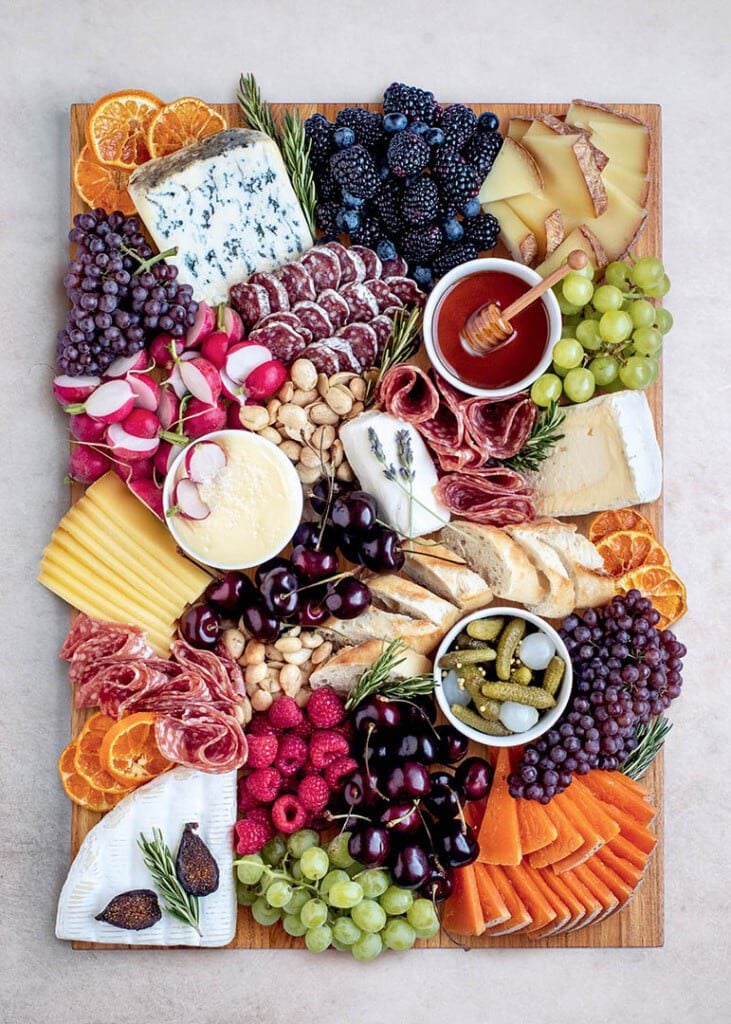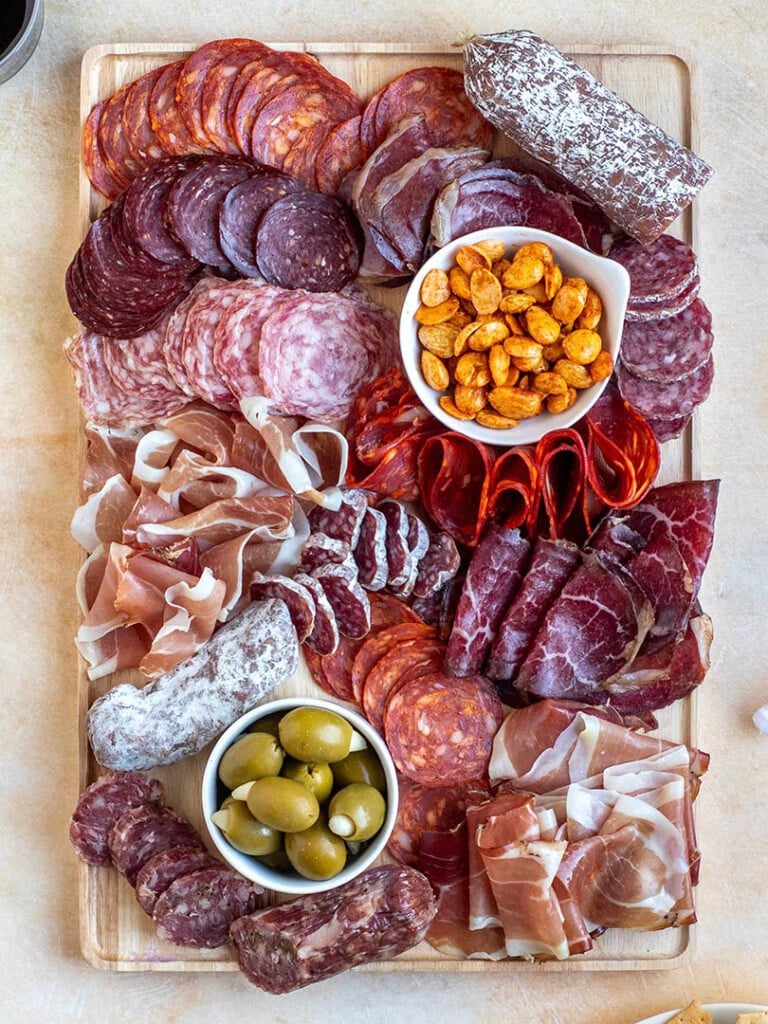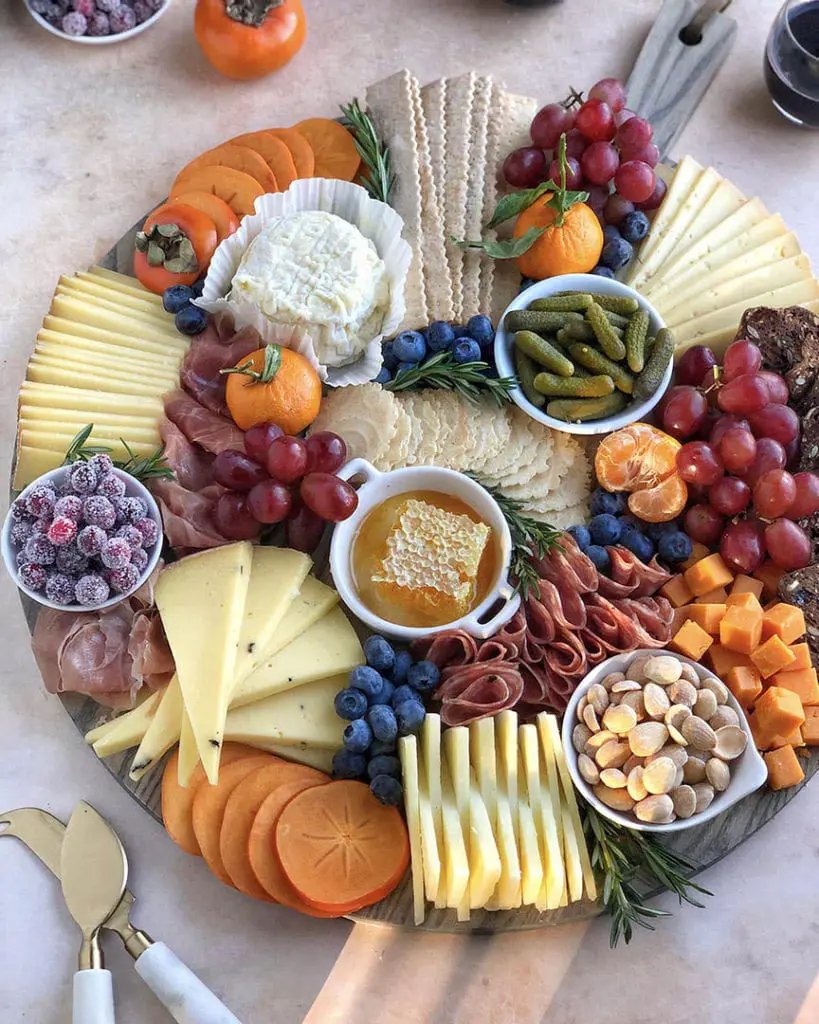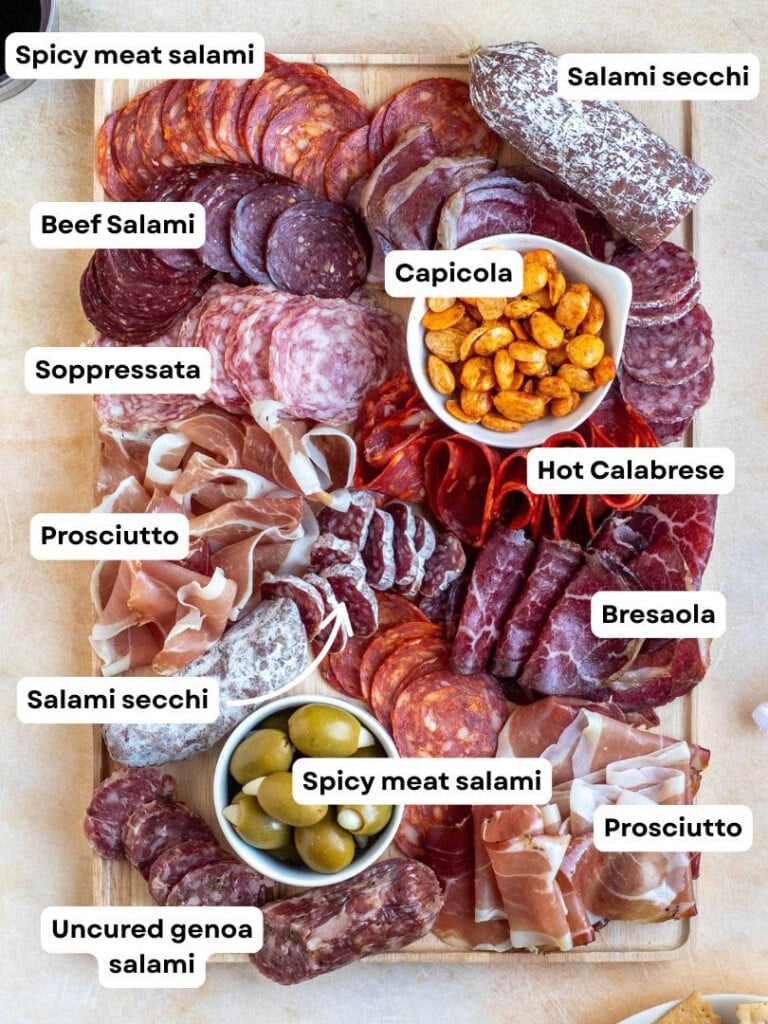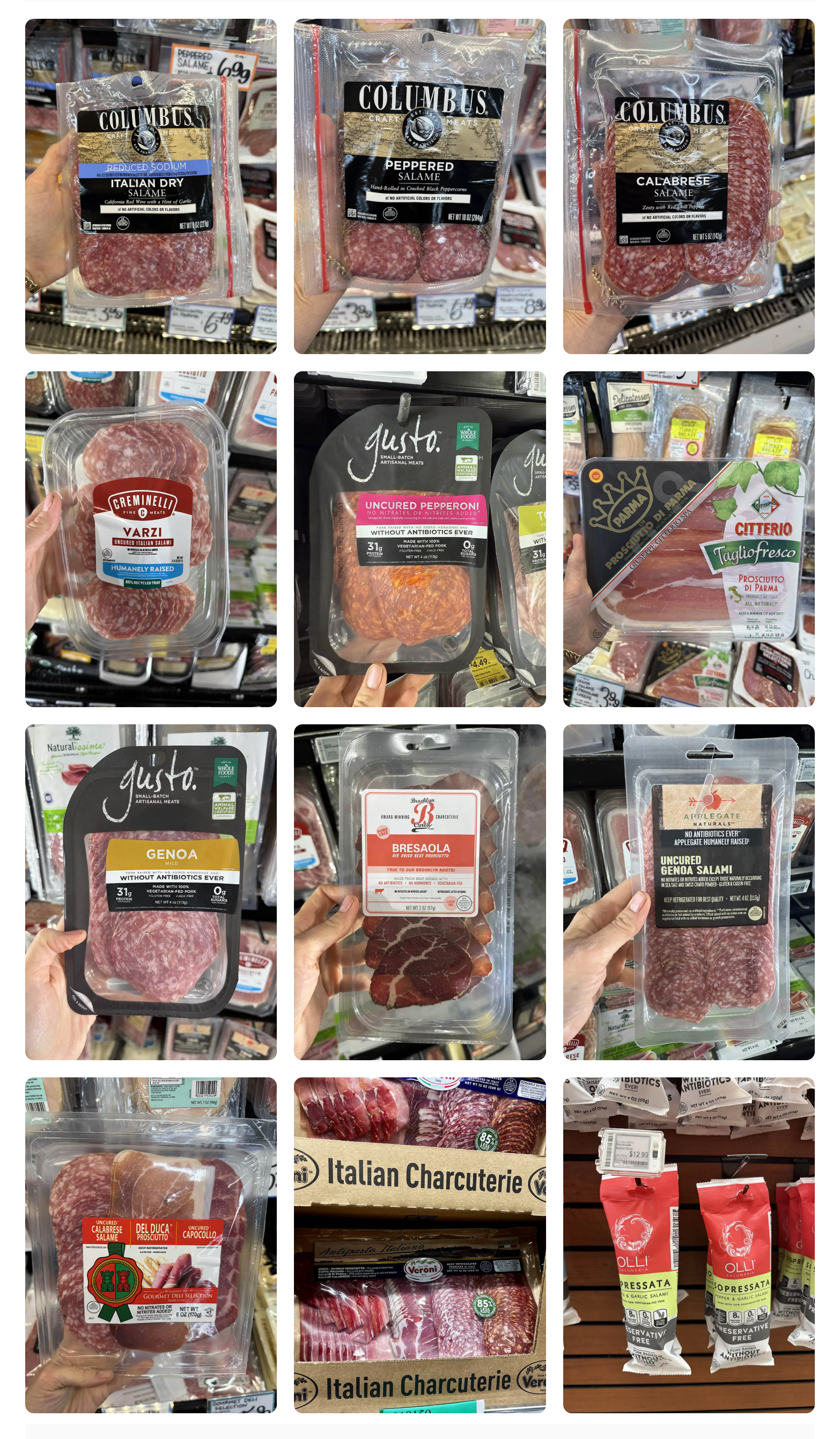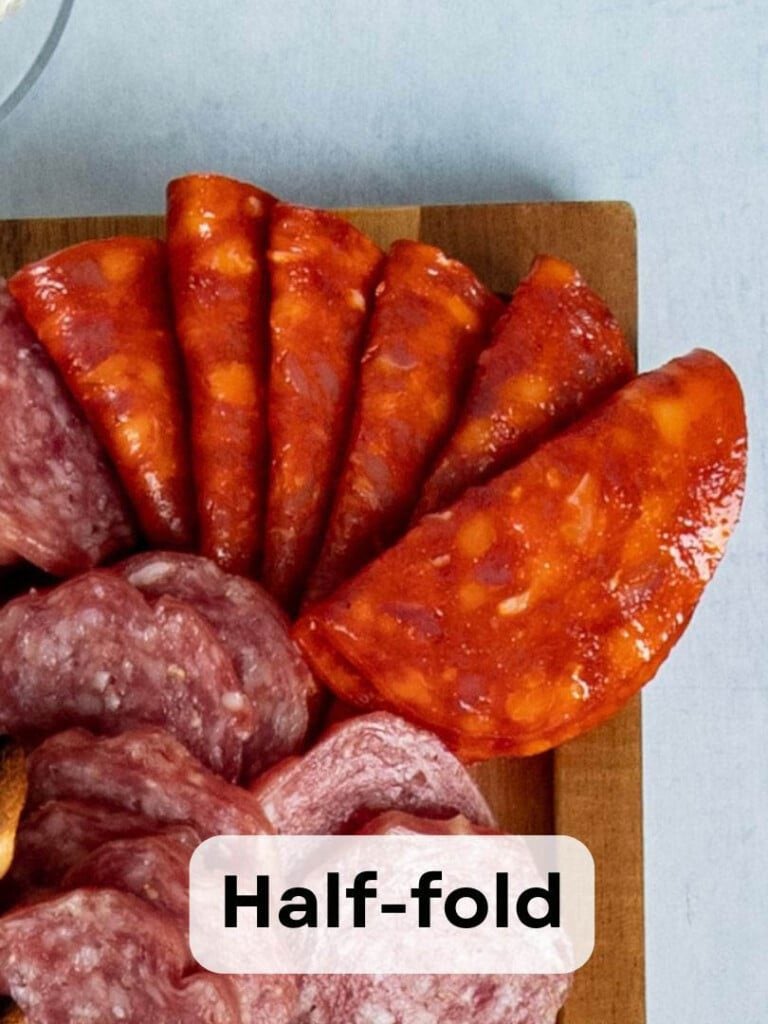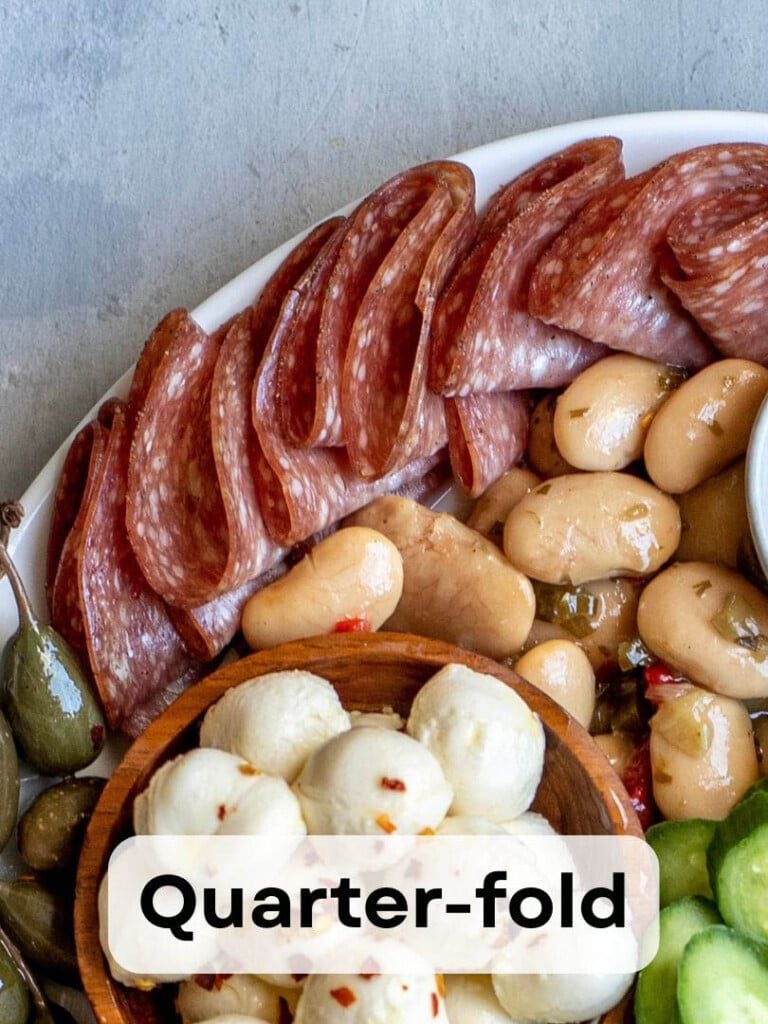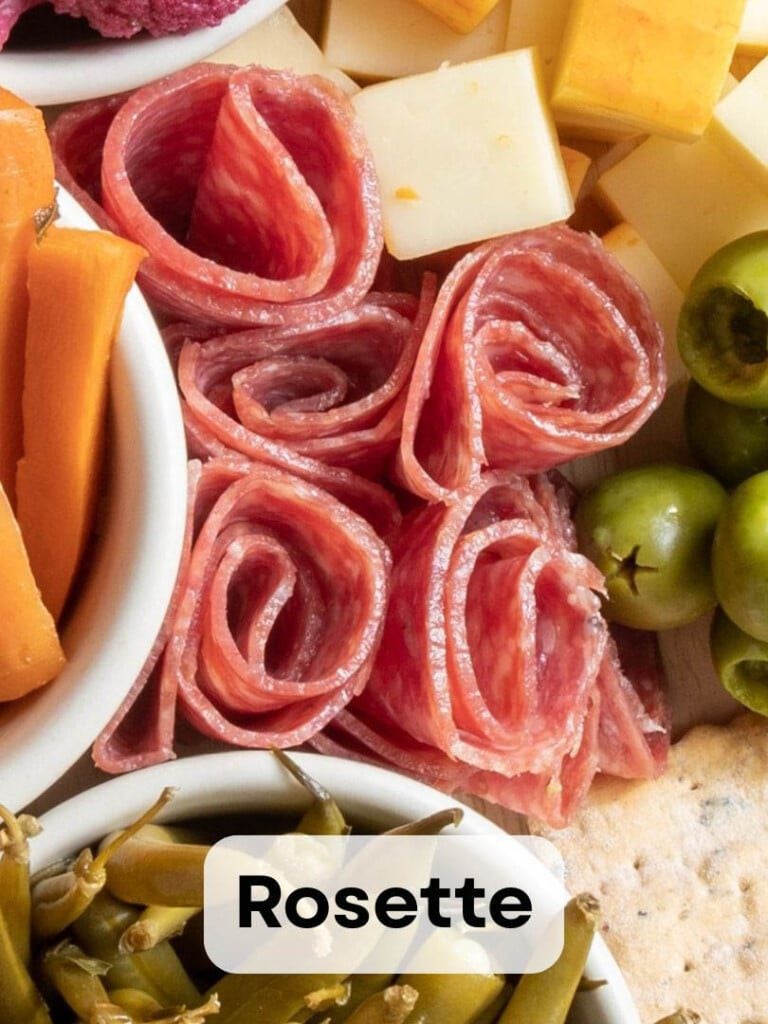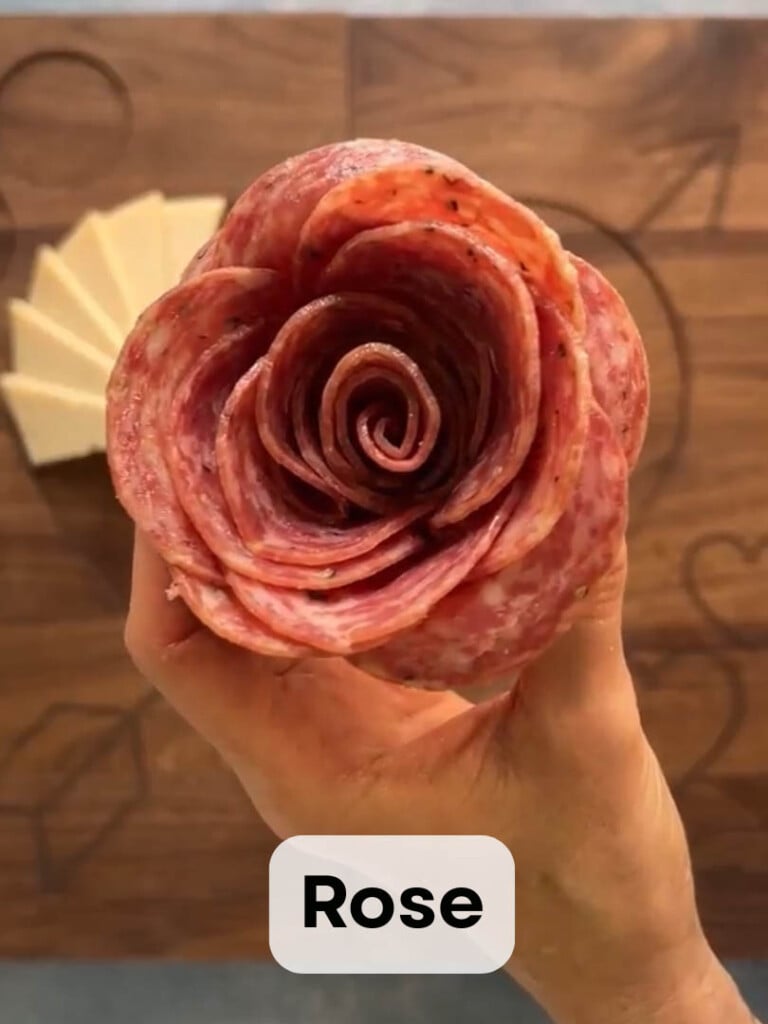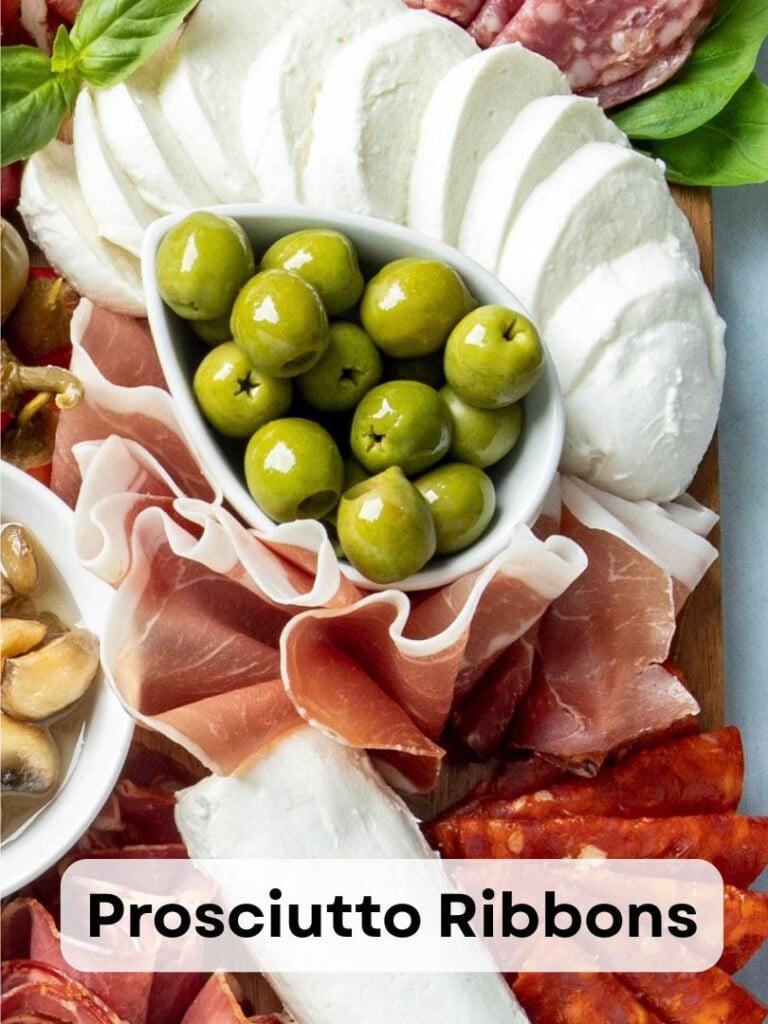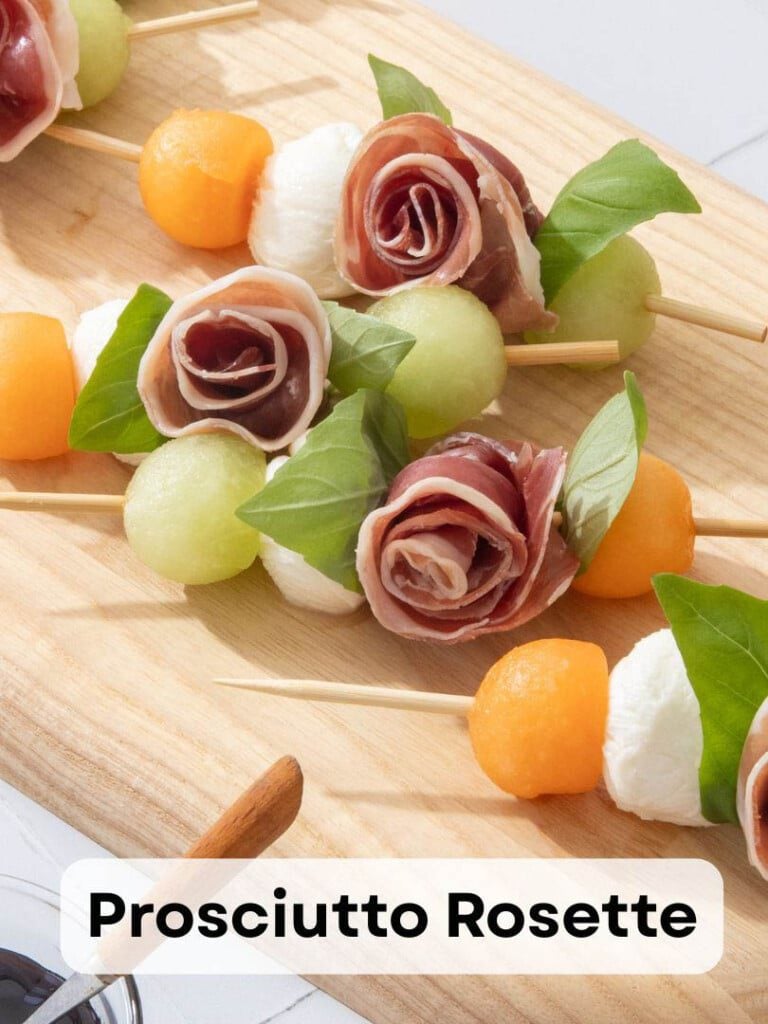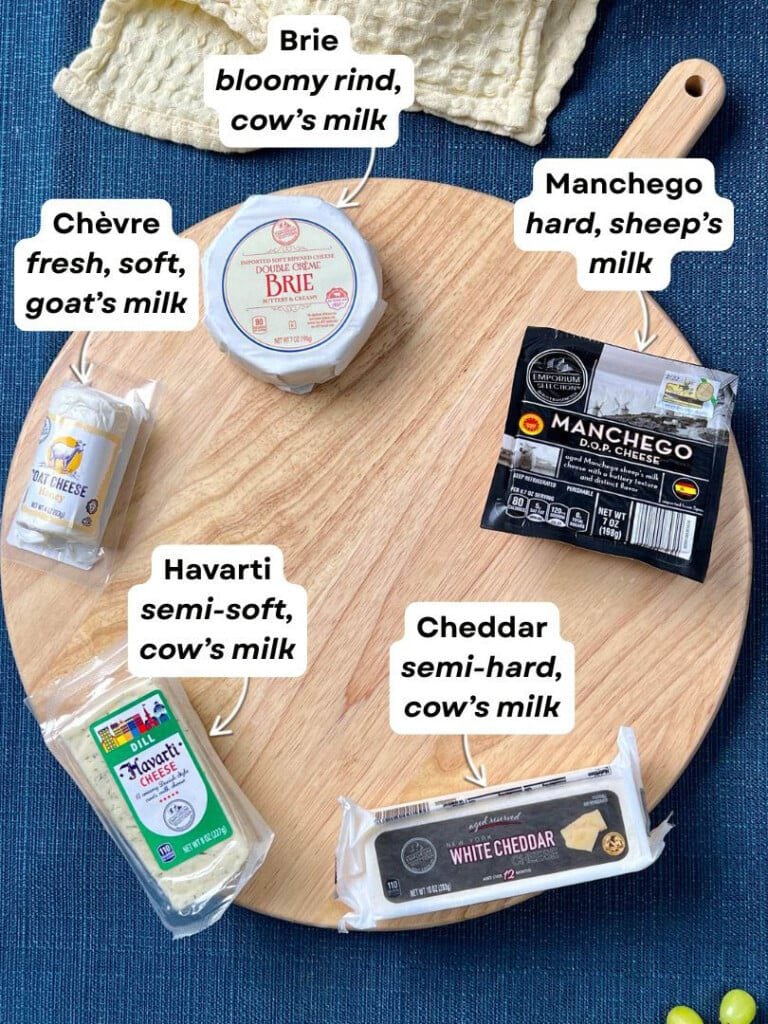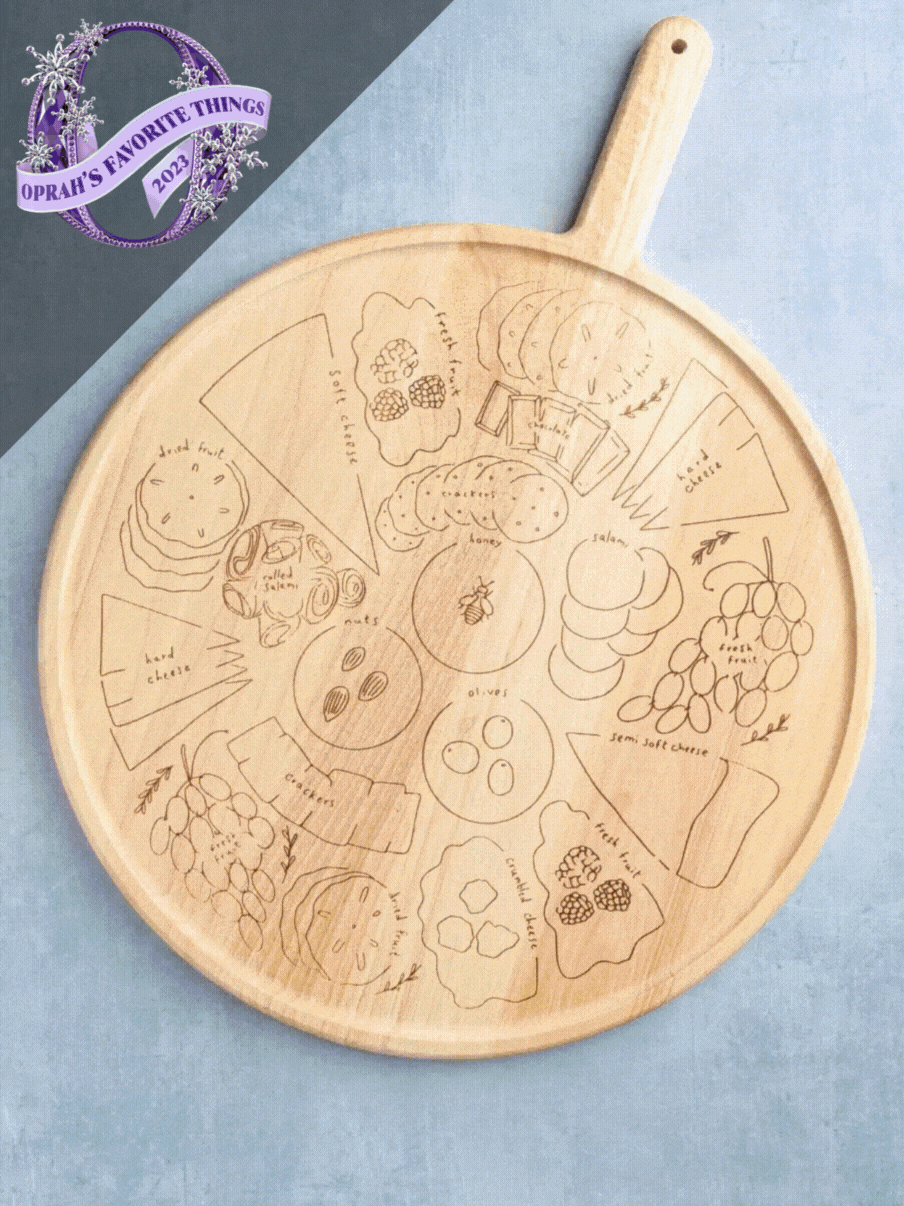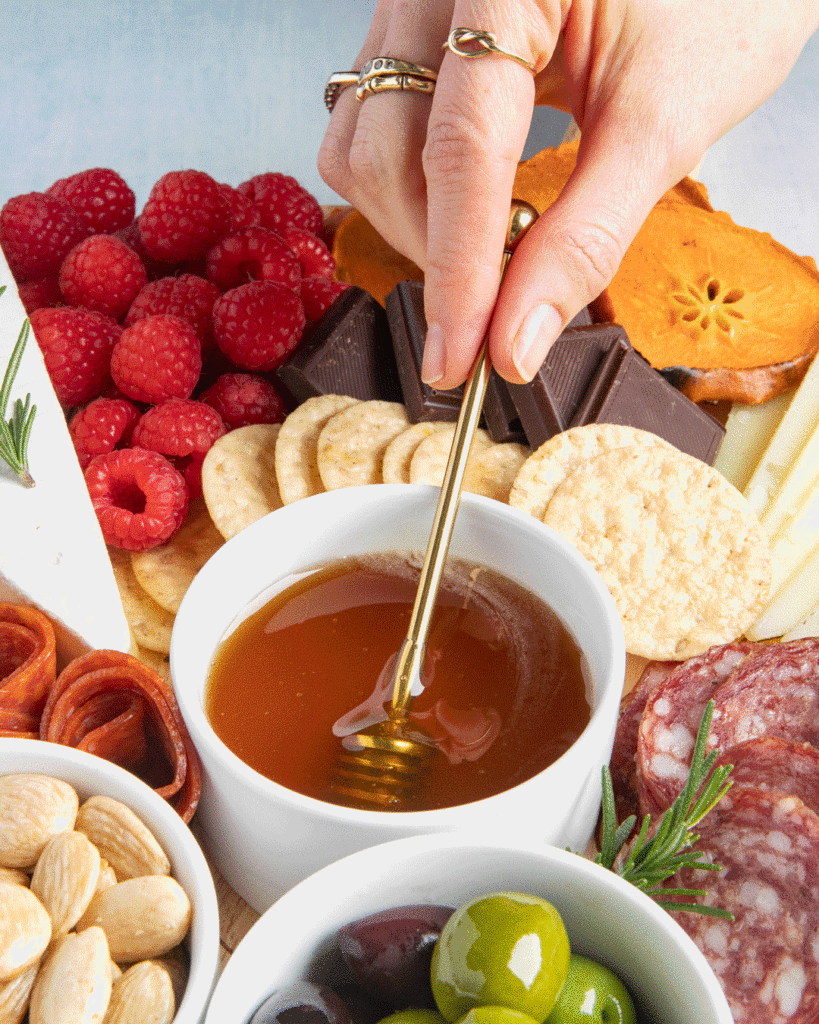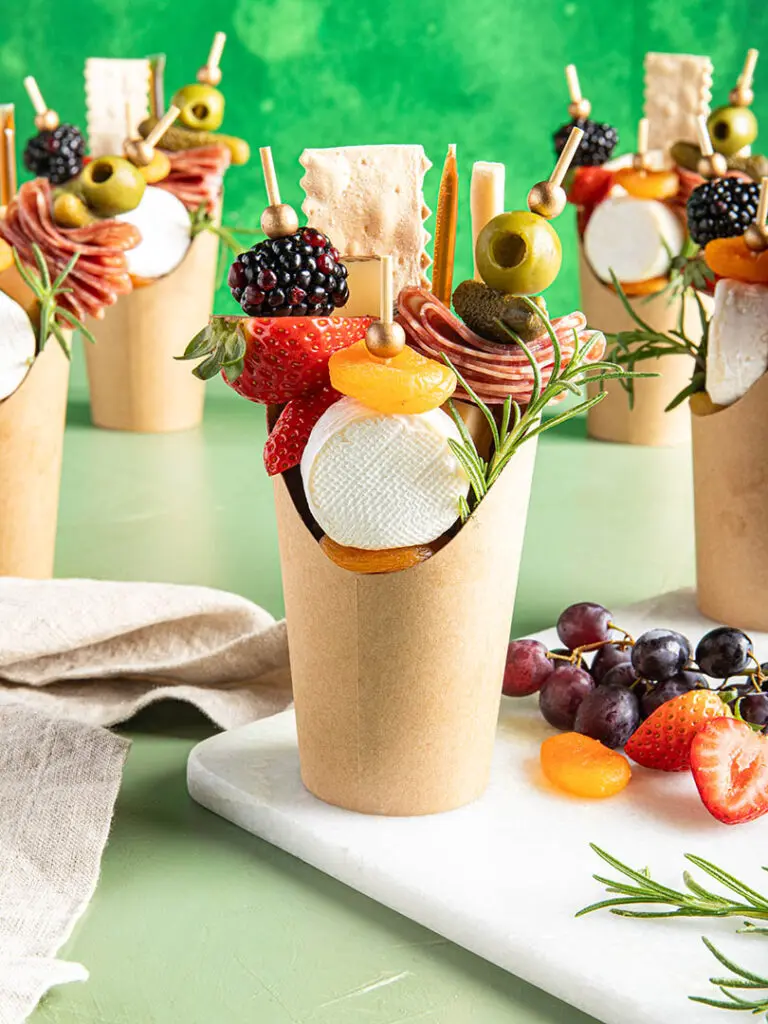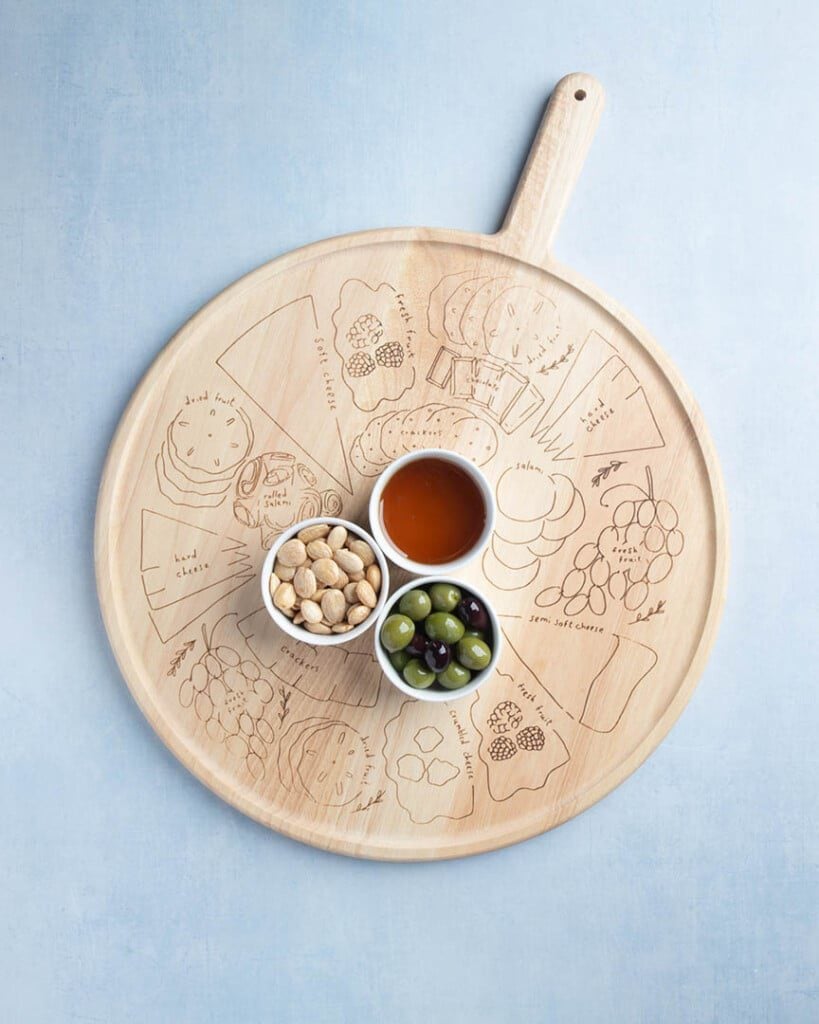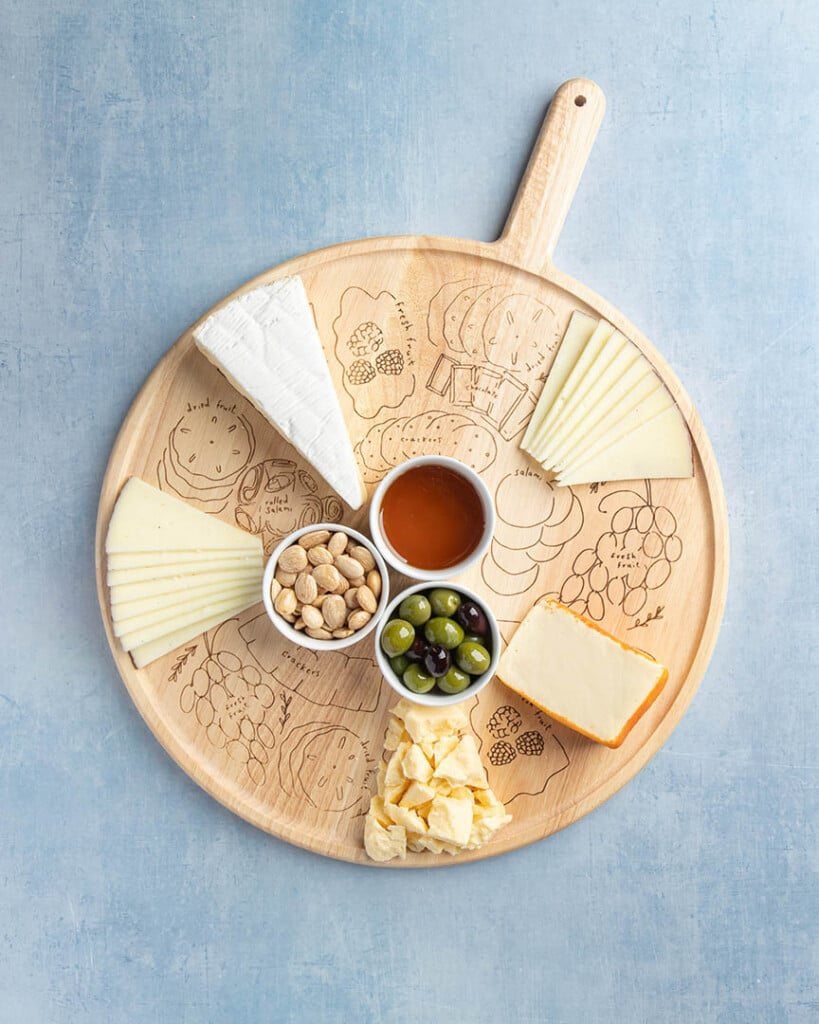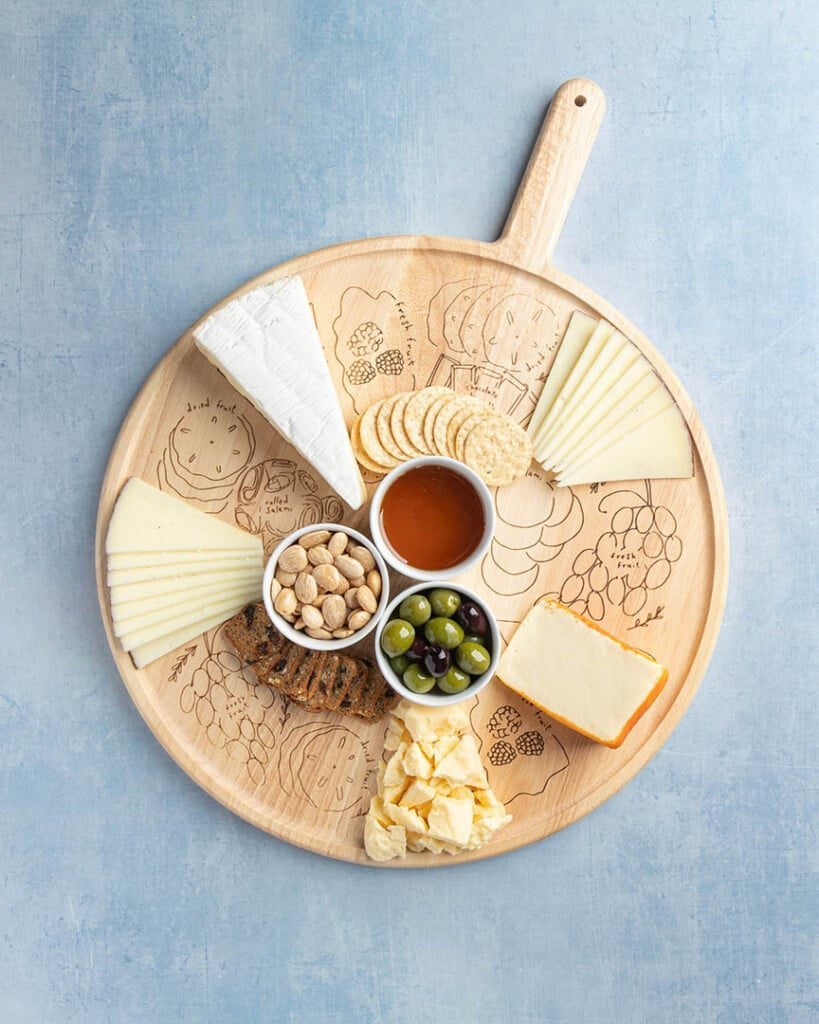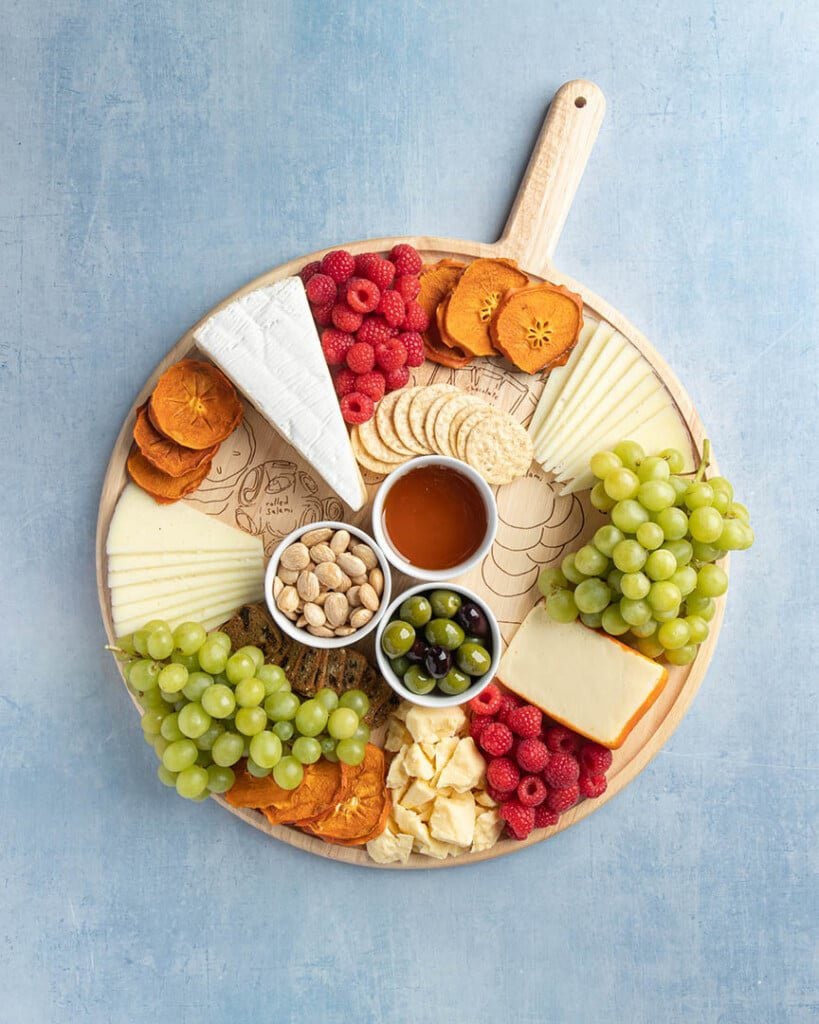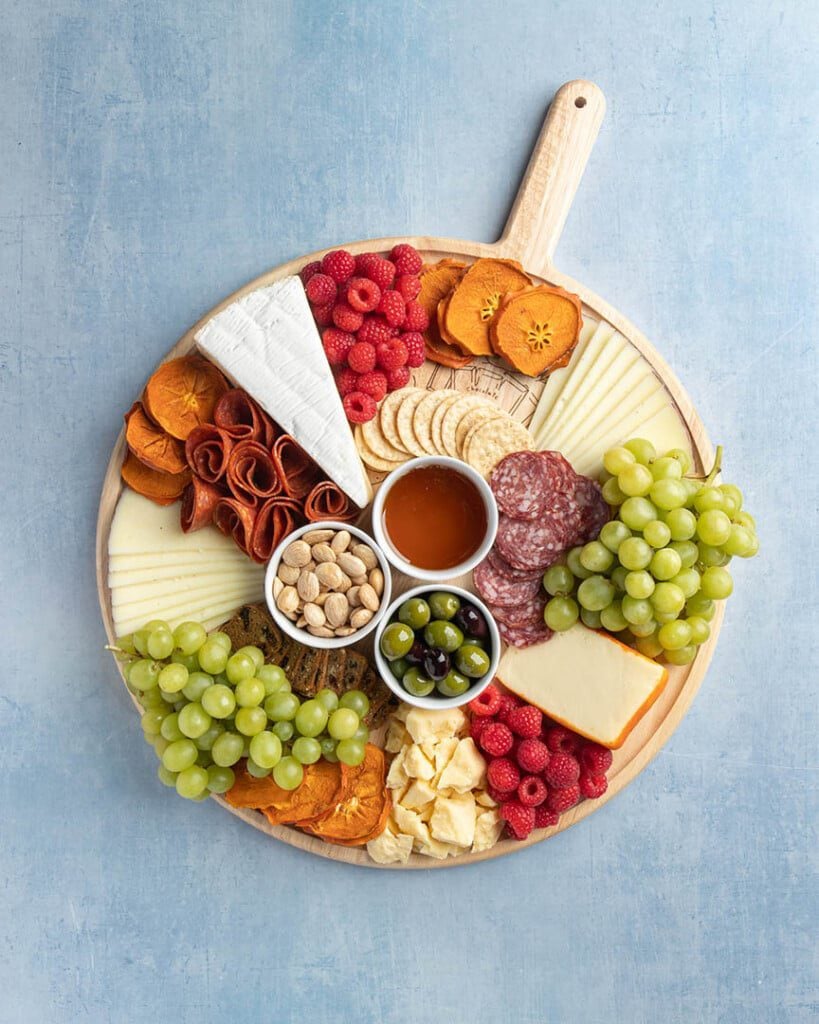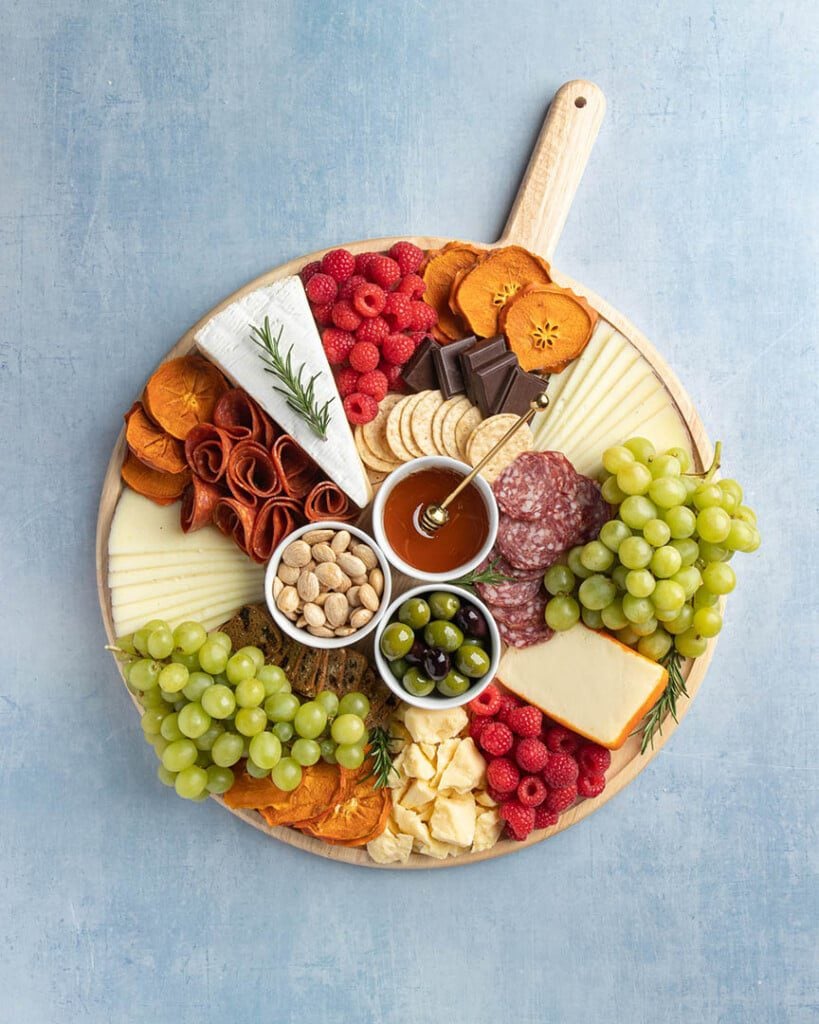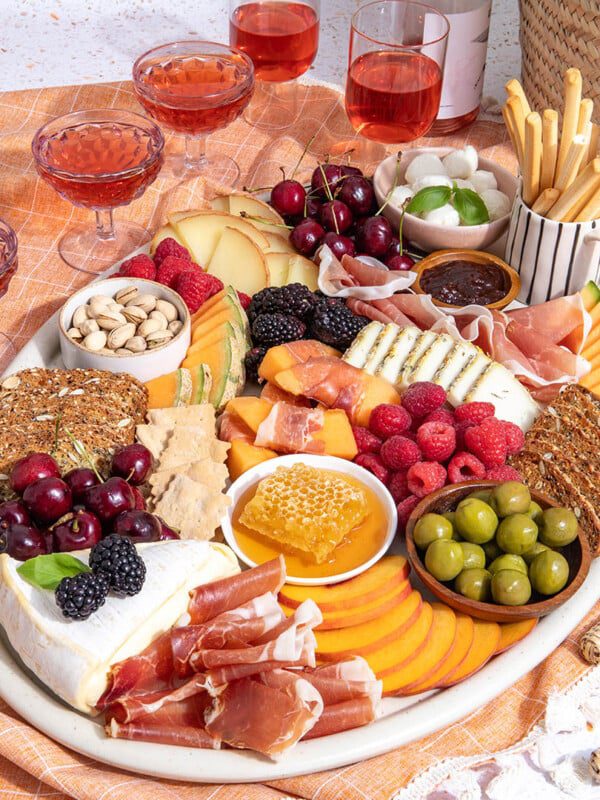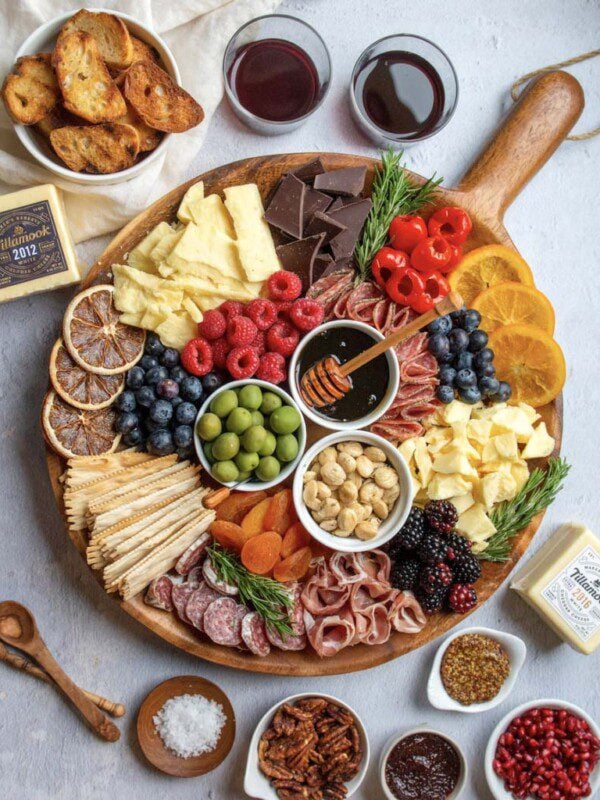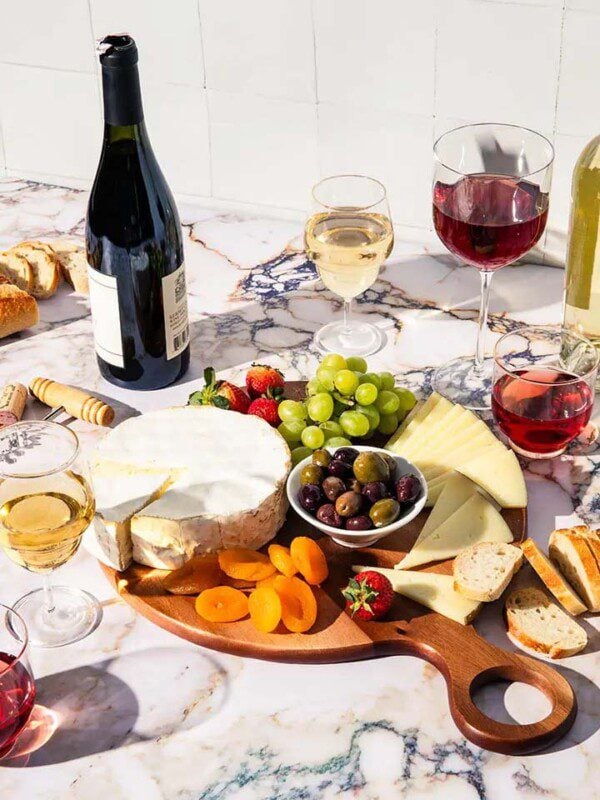What to Put on a Charcuterie Board: An In-Depth Guide
Jun 30, 2025 Updated Nov 13, 2025
How-to Guides Cheese Boards Charcuterie Boards Thanksgiving Board Ideas Beyond the Board
This post contains collections of products that I personally recommend (it may contain affiliate links).
What do you put on a charcuterie board? Great question–it’s one of my favorite things to talk about, hence why I have a whole website dedicated to charcuterie and cheese boards! In this post, we’re going to go back to basics for a 101-style primer on everything you need to know to put together a show-stopping centerpiece for just about any occasion!
What Is a Charcuterie Board?
So what is charcuterie, you ask? Let’s start with how to pronounce it (hint: it’s not “charcoochie”). The real pronunciation is (shar-koo-te-ree), and it’s a French term referring to cooked, processed, or cured meats and meat products that are served cold, and the actual establishments that sell said meats. (See more on the types of meats below!)
The word “charcuterie” is believed to come from two French words: chair, which means “flesh,” and cuit, which means “cooked.” The practice itself was born from the need to not waste any food in 15th-century France, when charcuterie is believed to have originated! If there was leftover meat from a meal, it would be preserved so it could be eaten for longer without spoiling.
On a traditional charcuterie board, the focus is on the meats. Sure, there will be some cheese and a few accoutrements like mustard, cornichons, and olives, but don’t confuse a charcuterie board with a cheese board, which is conversely all about the cheese. (Learn more about accoutrements later!)
While it’s true that a cheese board and charcuterie board are not actually interchangeable, the term has evolved to lean more cheese-heavy than the traditional meat-centric spread. Vice even interviewed me about the connotation of “charcuterie”! I’m nothing if not adaptable, so my rule of thumb is: as long as a board has cured meats on it, I use the term charcuterie! However, I will be the first to admit that I break the rules when there is a fun play-on-words!
What Goes On a Charcuterie Board?
I love a full spread, so I tend to go for the more is more approach when it comes to shopping. If you don’t want to have leftovers or want to be more budget-conscious, a good rule of thumb for shopping is about 3 ounces of meat and 3 ounces of cheese per person. But keep in mind who you’re serving! If you invite me, for instance, I’d probably eat more than my share. Just saying!
When it comes to purchasing, you can go to a specialty cheese shop, but you can also shop at your local grocery chains, like Costco, Trader Joe’s, Aldi, and Whole Foods.
Charcuterie Meats
In my experience, these are the most commonly served charcuterie meats! I like to serve varying combos…
Salami: A sausage made from fermented or dried meat, typically pork. The most common is Genoa salami, which is served thinly sliced. (I love to use my Salami Chips to change it up!)
Soppressata: A type of salami made from leaner cuts of meat and pressed into that familiar, firm log. There are many different styles, and it’s usually sliced on the thicker side.
Prosciutto: This dry-cured ham (hind leg) is sliced very thin and loved for its buttery texture.
Jamón Ibérico: Similar to prosciutto, Jamón Ibérico is cured ham (hind leg), but that’s where the similarities end. This charcuterie is specific to the Iberian Peninsula (aka Spain and Portugal) and comes from the black Iberian pig. This pig’s acorn-rich diet is what gives the meat its sweet, nutty flavor and buttery soft texture!
Jamón Serrano: While this is also a Spanish cured ham (hind leg), it tastes quite different (and is more affordable!). Jamón Serrano, which translates to “ mountain country ham,” is made from white pigs, which eat a grain-based diet, and is cured for a shorter amount of time. It’s milder and saltier in flavor!
Coppa (aka Capicola): Another type of dry-cured ham (shoulder) that is sliced very thin. It’s more tender than buttery.
Bresaola: Also dry-cured and salted meat, but this one is beef instead of pork. This is the best option for people who do not eat pork. (You may want to serve it separately to avoid cross-contamination.)
Spanish Chorizo: A spicy, cured sausage usually made from pork–think of it as a Spanish-style salami! (I like to serve it with other Spanish flavors, like on my Tapas Board)
Mortadella: A cured Italian cold cut studded with pork fat and peppercorns (though sometimes you’ll find pistachios!). It originated in Bologna, Italy, and it’s essentially fancy deli bologna (hence the name!)…but way better.
Charcuterie Meat FAQs
The designation is set by the USDA, and the difference has nothing to do with if the meat is preserved, but rather how. “Cured” meats are preserved with chemical preservatives like sodium nitrite, while “uncured” meats are preserved with natural preservatives, such as celery powder and sea salt.
There aren’t technically any ethical certifications for charcuterie, but look for phrases like “raised with care” and “certified humane,” and do brand research!
Beyond serving ethically-sourced meats, plan ahead so you can serve smaller portions to minimize waste and try to only buy things that you know you’ll want to eat as leftovers!
In general, it has been said that it’s best to avoid preserved meats while pregnant due to the possibility of bacterial infections, but certainly, ask your doctor directly to understand what is best for you.
Once opened, they should all be stored in airtight packaging in the fridge for up to 5 days for the safest results! Cured meats, like salami, will store longer at slightly warmer temperatures, whereas cooked meats, like mortadella, need to be kept in the colder cheese and meat drawer and get consumed faster.
You don’t have to go to a fancy butcher for great charcuterie; there are plenty of great brands available at your local grocery store. My go-to is Columbus Crafts Meats. If you’ve been around for a while, you know I regularly put them on my boards–I particularly love their Italian Dry Salame (including the low-sodium option), Peppered Salame, and Charcuterie Tasting Board.
Other great brands to look out for are Creminelli (I love their Varzi), Fiorucci, Gusto, Brookly Cured (including their Bresola), Olli Sumeria, Applegate Organics, and Citterio (I love their prosciutto, which you can find at Trader Joe’s).
If you’re new to charcuterie meat or just like a variety on a budget, I highly recommend sampler/variety packs. Columbus offers a great Charcuterie Sampler 4-pack and Charcuterie Trio, Trader Joe’s has a few, and Costco usually has an awesome sampler of 5 different meats.
How to Fold Meat for Charcuterie Boards
There are a number of ways to present charcuterie meat on your charcuterie boards, and my number one rule is to never serve it lying flat/straight out of the package. It looks cheap, and it’s hard for guests to grab. Instead, take each piece and arrange it on your board.
6 Ways to Fold Charcuterie
- Salami Half-fold: Simply fold in half and then arrange in a line, fanning them out on your board
- Salami Quarter-fold: Fold once, then fold again so that the salami is in quarters, then tuck into a spot on your board.
- Salami Rosette: Fold in half, then roll into a cone and tuck into a small place within the board to help them retain their shape.
- Salami Rose: Using a glass or cup, fold a slice of salami over the rim, then overlap with more so the rim is covered. Layer overlapping slices on top until the layers of salami come together in the center of the glass, forming a rose-like shape.
- Prosciutto Ribbons: Fold a piece of prosciutto in half lengthwise, then make accordion folds starting with the short end.
- Prosciutto Rosette: Fold a piece of prosciutto in half lengthwise, then roll starting with a short side to create a rosebud shape and secure with a toothpick.
Pro tip: Folded meats can easily unfold if you put them down without a plan. For this reason, I often add the meats towards the end of my assembly. This way, I can fold a bunch of them and put them together into holes on the board between other items.
Best Cheeses for a Charcuterie Board
If you’re familiar with my Cheese Board 101, you’ll know that I always tell folks to serve a mix of hard and soft cheeses in an array of slicing styles and made with various types of milk (cow, goat, sheep, and even buffalo). As you will see below, there are some categories that have crossover here
Fresh: unaged, soft and creamy, think chevre, burrata, ricotta, feta
Bloomy rind: rich, buttery, and complex with a soft rind, think Brie, Camembert, Mt Tam
Blue: tangy, acidic, bold: think Gorgonzola, Roquefort, tilton, Blue d’Auvergne
Soft: These cheeses are spreadable and usually buttery in texture! Brie, Camembert, triple-cream, burrata, chevre, and Humboldt Fog (one of my all-time faves!).
Semi-soft: There’s a huge range of cheese in this category because the main point of classification is having a water content under 45% and above 36%. They’re soft but not necessarily spreadable. Try: Stilton, smoked mozzarella, gruyere, morbier, taleggio, fontina
Semi-hard: They’re firm, but not crumbly; some of them are coated in a wax rind, like gouda, cheddar, Jarlsburg, and manchego.
Hard: These are your salty, crumbly cheeses, think: Parmigiano Reggiano, mimolette, Asiago, Grana Padano, Pecorino Romano.
How to Cut Cheese for Charcuterie Boards
The rule of thumb is to pre-cut hard cheeses on your boards so that it is easier for guests to serve themselves. Soft cheeses can stay intact because they are easy to slice and serve (though sometimes I use my favorite brie wheel cutting hack and pre-cut goat cheese logs and mozzarella balls into medallions).
There are traditional ways to serve up various cheeses so that they both taste their best and look recognizable. For instance, manchego is often served in a triangle with the rind on. And while you do not eat the wax rind, you keep it on the end of the triangle to help people identify it.
Similarly, putting a whole block of Parmigiano Reggiano on a board would be hard for someone to serve themselves, but you can break off into crumbles and lay out tongs so everyone can have the perfectly sized pieces of the cheese.
For more examples, I started a whole series on how to slice cheeses on TikTok. Check out these videos below for tips you can apply to your favorite cheese.
Accoutrements for a Charcuterie Board
Pronounced “uh·koo·tr·muhnt,” these are the non-meat or cheese accompaniments that complement and enhance the flavors on your board. This can be anything from nuts to olives to dried fruit to jam! Here is a list of my favorites from savory to sweet options:
Sweet Accoutrements
- Fig jam (or other type)
- Honey (comb optional!)
- Quince paste (see my tapas board for more on this)
- Dried persimmons
- Dried apricots
- Candied nuts
Savory Accoutrements
- Castelvetrano olives
- Marinated olives
- Cornichons
- Marcona almonds
- Giardiniera
- Mustard
- Spicy nuts
Produce to use on a Charcuterie Board
Grapes, berries, and figs are charcuterie classics, but I always try to shop seasonally! I also feature a lot of citrus to help break up the rich and salty flavors of the meats and cheeses. I suggest having 2 to 3 fruits on your board for a diversity of flavors and colors to make the board inviting for your guests. These are the fruits I use the most because they hold up the best:
- Green & red grapes
- Blueberries
- Strawberries
- Blackberries
- Clementines or oranges
- Pomegranates (mainly the seeds/arils!)
- Stone fruits (like peaches)
Notes:
- Raspberries are a favorite of mine, but they can get soggy and stain your boards.
- Be sure to wash and dry your produce thoroughly before serving.
- Budget-wise, shopping seasonally can help with the cost of produce. Non-organic is cheaper than organic, but I prefer to shop organic.
Carbs for a Charcuterie Board
You know I love crostini, but you can also serve sliced fresh bread and/or a variety of your favorite crackers. For more cracker pairings, check out my ultimate cracker guide.
- French bread
- Baguette
- Grissini: Italian breadsticks
- Water crackers: a savory classic with a neutral flavor that pairs well with most cheese
- Multi-grain crackers: hearty, versatile, and pair well with most cheeses
- Butter crackers: rich, buttery flavor that pairs well with most cheeses
- Rye crackers: strong flavor that pairs well with soft, mild cheese
- Rice crackers: crispy, savory, and pair well with more savory cheeses (these are usually gluten free!)
- Wafer crackers: thin, delicate, and airy in texture, and pair nicely with soft cheese
- Flatbread crackers: thin, crispy, and neutral, which pair well with most cheeses
- Herb crackers: usually bold in flavor with a huge array of ingredients; each type of cracker will pair differently with cheese. My rule of thumb is the more savory the cracker, the sweeter or more mild the cheese, and vice versa.
Charcuterie Board Accessories
Types of Charcuterie Boards
When it comes to boards, I personally prefer wooden ones because they come in so many different shapes and sizes, but it all comes down to preference!
You can buy boards from most stores, including my collection on Amazon and World Market, on my Shop page!
Wood: Wood is a relatively soft material, so it’s easier on your knives. That said, they do require a little more upkeep in terms of cleaning and conditioning. They lean rustic in style, but they come in such a huge range of shapes, sizes, and wood types that it’s easy to match with your aesthetic. Plus, you can use a board with a groove around the edge to serve juicier ingredients (ahem, burrata).
I am, of course, partial to my collection of charcuterie boards & accessories, including my charcuterie map boards. I suggest getting either the round charcuterie map board or rectangular charcuterie map board. They make putting a charcuterie board together easy by telling you what ingredients to buy and where to place them on your board.
Marble: Marble has a very clean look and they’re super easy to clean and care for (i.e., there’s really no upkeep at all!). What they’re especially great for is maintaining temperature. If you are serving refrigerated goodies, they will stay cooler on marble than on wood.
Slate / Stone: Similar to marble, slate boards hold temperature well! They have a more rustic appearance and may also be a little more delicate than marble in terms of breaking.
What Size Charcuterie Board Do I Need?
It’s probably not surprising that I have a big collection of boards! You certainly don’t need more than a couple, but keep in mind that different-sized boards will serve a different number of guests!
- Small (10–12 inches): Serves 2–4 people
- Medium (14–16 inches): Serves 5–8 people
- Large (18+ inches): Serves 10+ people (if you’re serving a huge party, or try my Grazing Table idea for 25 to 40 people!)
Charcuterie Board Knives & Utensils
Having multiple cheese utensils is essential to prevent cross-contamination, but it’s also an ideal experience for guests. You can always pull together knives, forks, and spreaders from your utensil drawer, but in terms of presentation, I like to have a cohesive set of cheese knives that are specifically designed for the job!
Typical sets will come with these 3 utensils:
- Pronged knife: This is a multi-purpose serving tool! It’s best for cutting semi-hard cheeses, like Gouda, and the prongs on the end can be used to pick up the cheese.
- Spade knife: This knife is best for breaking apart hard cheeses and chipping away tough rinds.
- Flat knife: This knife looks like a tiny cleaver and is best for slicing semi-hard or semi-soft cheeses like cheddar.
More advanced sets usually also have:
- Soft cheese knife: The holes in this knife give the cheese less surface to stick to, so it’s ideal for slicing soft and semi-soft cheeses.
- Cheese fork: Best for semi-hard and hard cheeses, you use this tool to hold the cheese in place while you slice or break cheese off the block.
- Spreader: Similar to a butter knife, this dull knife is best for spreading those super soft, creamy cheeses.
If you, like me, serve honey on your boards, use a honey dipper! It’s so much easier to serve honey with a dipper than a spoon–you get a nice, delicate drizzle rather than a big blob.
Bowls & Serving Vessels
- Small bowls / Ramekins: These little bowls are essential for serving a winning cheese board. You can use them to hold small, loose accoutrements, like nuts, and they’re also great for keeping wet and/or oily items like cornichons and olives from contaminating nearby foods. I also use them for serving dips, jams, and honey! You can find cute labeled ramekins in my Charcuterie Board Gift Set.
- For serving: You can always use standard plates or bowls, but I also like to mix it up with small jars, bamboo boats, paper cups, and paper or wooden cones!
How to Arrange a Charcuterie Board
Welcome to Meat & Cheese Platter Building 101! Here’s my step-by-step guide on how to put together just about any charcuterie board… but first, a couple pro tips:
- Arrange items in odd numbers (groups of 3 or 5 look best)
- Separate similar colors and similar textures
- Create height by stacking cheeses and/or crackers
- Let your cheese come to room temperature before serving
Step 1 – Ramekins / Bowls: Add any wet and/or messy accoutrements or dips to small bowls or ramekins to keep everything tidy and contained, then place them on the board first to anchor it and give yourself a guide for placement.
Step 2 – Cheese: Leave your soft cheeses whole (if they’re super messy, like La Tur, you can even leave them in their packaging!) and cut your harder cheese how you like them (see cheese cutting tutorials above!). Start by adding the whole cheeses to the board, then add the cut cheeses in different sections, being sure to space them out. Sometimes I like to fan cheese out around the ramekins!
Step 3 – Carbs: Add crackers if you have room (usually I like to put a few and then serve the rest on the side to make room for all the other goodies, but that’s totally up to you!). Check out my Ultimate Cracker Guide for more.
Step 4 – Produce: Add in colorful fresh fruits (and dried fruits if using), being sure to separate similar colors. Make sure to also keep the super moist produce away from super dry carbs.
Step 5 – Charcuterie Meats: Add meats directly to the board in the open spaces! I like to fold the meats and tuck them into pretty designs (see folding tutorials above!) around my ramekins and cheeses.
Step 6 – Garnish: Add any garnishes, like edible flowers and/or herbs (my fave are rosemary sprigs), and serve!
Check out this video tutorial for extra guidance!
Common Mistakes to Avoid When Making a Charcuterie Board:
- Overloading the board (don’t be afraid to serve the crackers on the side)
- Choosing too many similar flavors or textures
- Too many strong-flavored cheeses
- Serving cheese cold
- Cutting cheese incorrectly (see cheese cutting tutorial above!)
- Placing crackers or bread next to wetter items (they will get soggy!)
- Overly juicy or oily foods that will contaminate the flavors of other items on the board
- Produce that browns quickly (like apples)
Step-by-Step Instructions for a Charcuterie Board
- Ramekins
- Cheese
- Carbs
- Fruit
- Charcuterie Meat
- Finish with chocolate and garnishing with rosemary.
Charcuterie FAQs
– Cheese: 2–3 ounces per person
– Meat: 2–3 ounces per person
– Crackers/Bread: A handful per person
– Extras: A mix of fruits, nuts, and spreads for variety
– Use store-brand cheeses and meats
– Avoid pre-sliced cheeses
– Avoid buying out-of-season fruits and veggies
– Serve dried fruits
– Buy things with long shelf lives in bulk: crackers, nuts, and spreads
– Make homemade spreads like honey butter or jam
– Check out my Trader Joe’s $65 budget board, Trader Joe’s $35 budget board, and Aldi budget board.
– Gluten-free: Be sure to include gluten-free crackers. If you still want to serve crackers with gluten, keep them away from the other food, and serve disposable knives so guests don’t touch the knives to the crackers and then contaminate the cheese!
– Dairy-free: There are tons of delicious plant-based cheese alternatives! Similarly, if you plan to serve dairy cheese, just be sure to keep the utensils separated to avoid cross-contamination.
– Vegan: Use all those plant-based cheeses and replace meats with veggies, fruits, and vegan accoutrements! If you plan to serve meat, dairy, and/or honey, keep them separate from the vegan ingredients.
– Best-case scenario is that your guests eat everything before this becomes an issue (cheese can safely sit out for about 2 hours)! Plus, most cheese wants to be served at room temperature and not cold.
– If you plan to serve a bigger board over the course of a longer time: don’t leave the board out in the sun, serve firmer cheese and hardier fruits, and keep more temperature-sensitive items separate and serve them over an ice tray
Yes! Go ahead and pre-cut the hard cheeses and pre-fold meat and store in the fridge, but don’t cut any of the produce until right before you serve! Fruits and veggies will spoil faster when cut. Add crackers and nuts before serving.
– You can disassemble the board and store the different components separately. Return shelf-stable accoutrements to their original containers, separate the cheeses and store in cheese bags or parchment paper, and wrap meat in plastic wrap. The fruit probably won’t keep, so eat it, freeze for your smoothies, or feed it to pets (check with your vet first and make a Bark-cuterie Board!) or backyard birds.
– You can also use the ingredients in various other ways: cheese is a great topper for salads and omelettes, charcuterie meat can be served on sandwiches or in pasta… you get the idea.
– Choose mild cheeses (like Colby Jack, mozzarella, mild cheddar, etc.)
– Use fun shapes with cookie cutters
– Use sliced fruits and small veggies (like baby carrots)
– Include familiar snacks like mini sandwiches, popcorn, chips, and/or fruit gummies
– Check out my Back-To-School Kid’s Charcuterie Board for ideas.
– Use a lipped tray and cover with tin foil, a covered container, or a charcuterie-to-go board, and arrange items tightly so they don’t shift
– Make it a snackle box!
– Carry crackers and bread separately to prevent sogginess.
In my opinion, the best drink pairing is one that you are sure to love. But if you’re looking to try something new, be sure to check out my Wine Pairing 101 for suggestions and best practices!
– Clean: scrub with hot, soapy water, but DO NOT SOAK!
– Care: Oil them with mineral oil semi-regularly to keep them from drying out
Beyond The Charcuterie
For those of us less concerned with the traditional definition, I also sometimes use the term to convey different categories of food that are arranged on boards:
Show Me Your Charcuterie
I hope this post inspires you to make your own charcuterie boards. Nothing makes me happier than seeing the snacks and spreads you create from my tips. If you make something inspired by this post, please tag me at @ainttooproudtomeg so I can see and share!
And, If you liked this recipe, please rate and review.

